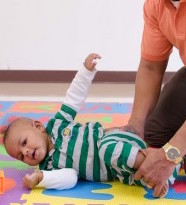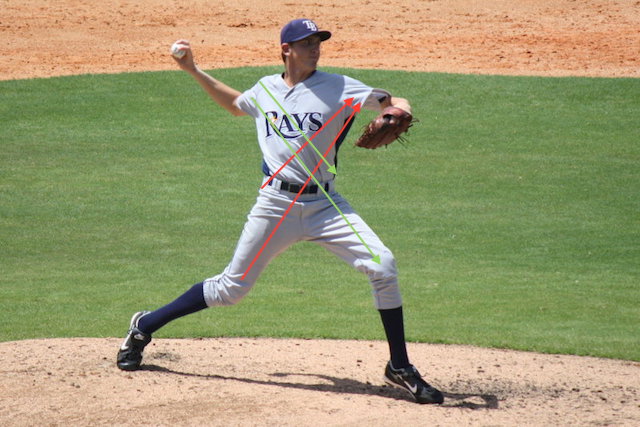What is the Oblique Sling
What is the oblique sling, and how does it affect me as an athlete? Are you a baseball player and want to throw harder and hit the ball further? Or are you a volleyball player that wants to increase arm speed and hit harder? Or are you a quarterback that wants to throw with a little more mustard? Your ability to do so is dependent upon your ability to load and create length through your oblique sling. This sling is our bodies personal whip. Understanding how to use it is a insanely effective way to improve sport performance.

What is the Oblique sling
Your oblique sling is a line of musculature that runs from your shoulder to the contralateral side of your pelvis. In other words, right shoulder to left hip and left shoulder to right hip. This line of musculature is what rotates our pelvis into side lying. As mentioned, it is our bodies own personal whip.

When looking at your torso, your oblique sling begins just above the hip at the internal oblique, moves to the rectus abdominus, to the external oblique, to the serratus, and into the pec on the opposite side. Picturing this line of muscle anatomically allows you to see its importance in generating rotation. It plays a huge role in all rotational sports. As a strength coach that works with mainly overhead and rotational athletes, this is an important concept to understand and continue to find new ways to address and fine tune.
Role of the oblique sling in throwing
Your oblique sling plays a massive role in the stretch reflex of throwing. Briefly, the stretch reflex is also known as the stretch shortening cycle. The stretch reflex involves eccentric lengthening of the muscles involved in the movement, which stores elastic energy, allowing us to generate power. An Eccentric contraction is followed by a period of amortization, which is the brief pause that allows for the transfer of the stored elastic energy to kinetic energy. This energy is released when the lengthened muscle contracts concentrically, finishing the stretch reflex.
When throwing, we enhance this stretch reflex by adding length to the movement, by separating between the shoulders and pelvis. This separation is known as the X factor. It creates a whip like effect, allowing you to throw far and hard. The longer the whip, the greater the speed. For a better visual, think Tim Lincecum. Properly loading and creating length through this sling while maintain ideal joint positioning allowed him to be the freak that he was and win two Cy Young awards early on in his career.
How to properly load this sling
Our ability to load this sling is dependent upon our ability to create and maintain Intra abdominal pressure (IAP) and ideal joint positioning. When we are able to maintain IAP and joint positioning, we have the ability to transfer maximal amount of force from the ground into the ball. Furthermore, improved joint positioning will allow for improved co-activation around a joint, allowing for maximal length through the sling, better loading through the stretch reflex, and the ability to generate/transfer more force into the ball. This all leads to greater velocity on the ball. There are genetic and structural limitations to our ranges of motion and differences in our ability to generate velocities. But, through training, we can get the most out of what we’ve been given.
Some of us weren’t born with insane genetics and coordination. And some of us experienced poor coaching that taught us faulty mechanics that stripped us of power and velocity. These athletes have a harder time getting the full benefits out of the oblique sling because they have lost the ability to properly load it. However, through training, we have the ability to increase each of these factors. We see increased throwing velocity, improved power production, and decreased pain in these athletes. Let’s dig a little deeper and see how we can enhance our oblique sling.
Ipsilateral pattern and Oblique sling
Throwing is an ipsilateral pattern. An ipsilateral pattern means one side is supporting while the other side is phasic. For example, if your throw righty your right side is phasic while your left side} is supporting. The supporting side is your strong front side that will give you fixed point to rotate into.

To look a little deeper, an athlete with ideal movement in this patterm will have the right and left side of their body mirror each other. When throwing, our throwing arm is typically in a position of external rotation, extension, and abduction. Our front arm, aka supporting arm should then be in a position of flexion, adduction, and internal rotation. These are completely opposite anatomical positions.
Tying in the Oblique Sling
Developmentally speaking, the line of musculature that makes up your oblique sling playes two roles. At roughly five months, the oblique sling is responsible for rotating a baby’s pelvis into a side lying position. At roughly 6 months the oblique sling then develops the ability to rotate the thorax onto the pelvis. In terms of baseball, the sling allows for the X factor (seperation between shoulders and pelvis), and for rotation. Together, these slings efficiently transfer force from right to left. For the case of our pitcher, this is the driving force down the mound towards home plate.

The oblique sling really creates a whip effect right before the release of the ball. Looking at this little video you can see the stretch within the oblique sling as the ball is released.
Training the Oblique sling
Getting great activation within you oblique sling isn’t the easiest thing to do. It is a very specific line of musculature that is often full of compensatory movement patterns such as internal rotation of the shoulder, extension of your spine, flaring of your ribs, excessive movement through the scapula, adductor tightness over activation of your hip flexors, etc. All the factors that have a say in the loading of sling could make it seem like a daunting task, however it’s not all that bad.
To get things rolling, there are a few guidelines that I always try to follow.
1. I start with breathing. Breathing is our most basic function that most of society does poorly. Normalizing it instantly improves loading, stabilization, and movement patterns at all other joint.
2. I move to developmental patterns so an athlete can begin to feel their oblique sling load, and we activate that pathway. This is also where I begin to show and explain ideal joint positioning. There have been times where my athletes mechanics have naturally improved while we work developmental positions. Something clicks within the ol’ brain and magic occurs.
3. Loading the pattern. People, I’m a strength coach! Yes, there have been multiple times where just these two steps were enough to get an athlete moving more efficiently, improve mechanics, and actually throwing harder. But if I know how to move further, let’s do it!
There are a few exercises that I love which really crank the oblique sling. Personally, I like loading the oblique sling with single arm dumbbell work like in the Mcgill Press, My own variation of a Cable row, Resisted and weighted DNS developmental patterns… I think training all exercises with great joint positioning will load your oblique sling. It's not like it just shuts off when you're not throwing, it assists in all movement patterns.
When we are able to handle load, we slowly work in velocities while maintaining great positions. This means rotational med ball work of all different varieties, kneeling, standing, lying, etc.
Conclusion
Understanding the loading potential of the oblique sling pays dividends in overhead sports. We as strength coaches have the ability to enhance how an athlete uses this line of musculature through three main avenues. First, we work to improve an athletes ability to create a longer whip through developmental positions, mobility work, and joint positioning. Second, we can enhance an athlete’s ability to generate force via strength training. And finally, we can generate greater velocities through the sling via strength training, and plyo work. This will improve force into a baseball, volleyball, football, or anything else that requires rotation!


